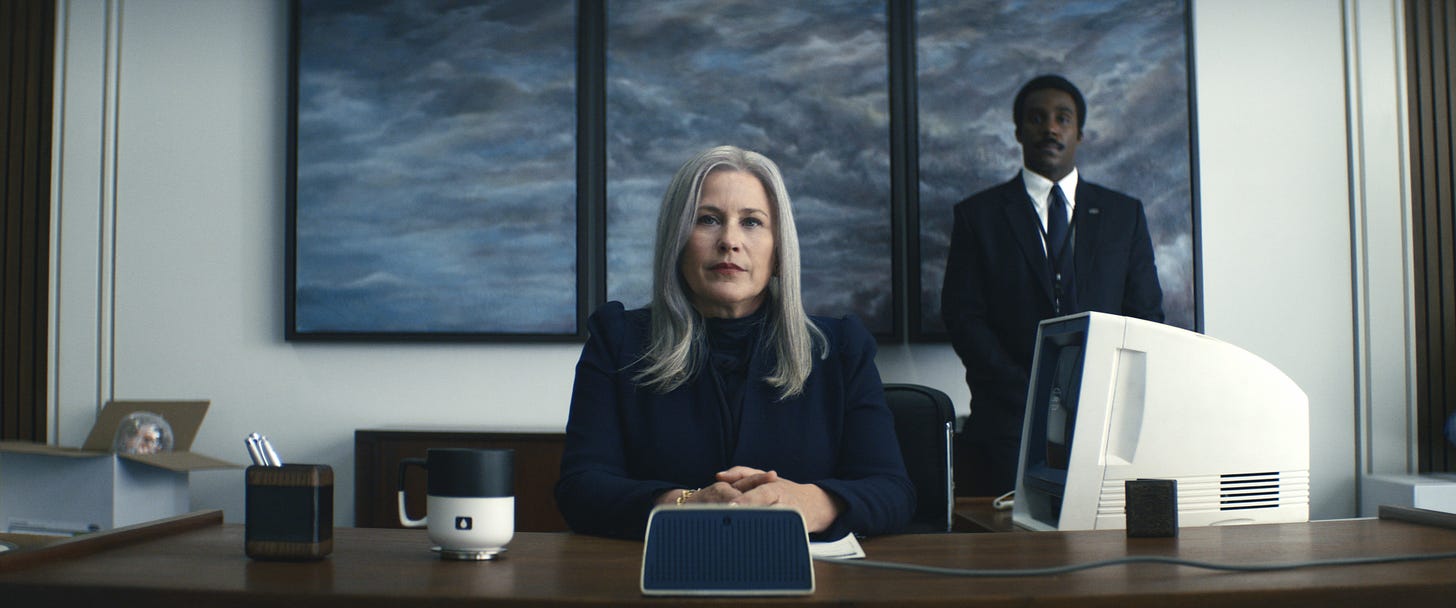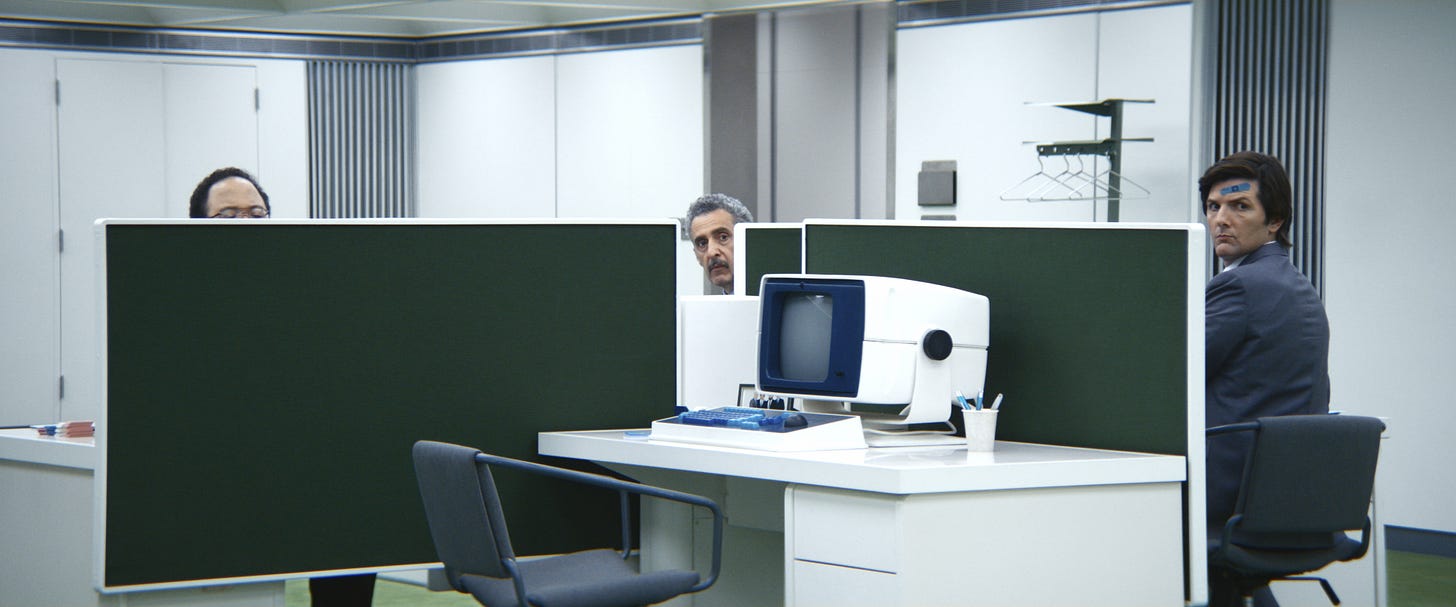Review: Severance, "Good News About Hell" | Season 1, Episode 1
A visually striking premiere orients us within Apple TV+'s labor dystopia
Welcome to my reviews of Apple TV+’s sci-fi labor dystopia Severance, which debuted last week. Ultimately, critics review shows either because everyone’s talking about them or everyone should be, and based on the early episodes this falls into the latter category for me, so I’m excited to discuss it here at Episodic Medium. All future reviews will be exclusively for paid subscribers, but I encourage everyone to give the show a shot regardless.
Reviews of the second and third episodes of the season will be sent to paid subscribers and posted to the site this afternoon and tomorrow.
The opening scene of Severance is a classic example of an in medias res opening, dropping us into Helly’s intake session after undergoing the eponymous procedure. Without additional context, we are just as confused as Helly: we don’t know where she is, we’re unfamiliar with the voice on the intercom, and we have no idea why she is unable to remember her own name or any other details about her life. The questions this disorientating orientation generates convince us to resist clicking back to see what else is on Apple TV+, or flipping over to a different app entirely, and invest us in discovering more about the dystopian world the show imagines.
What I found striking about the opening episode of Severance, though, was how swiftly our understanding of this world far surpasses that of any of its characters outside of one we only meet at the very end (and maybe some others, but we’ll get to that). Once the premise of the series—workers willingly undergoing the “severance” procedure that severs their work self from their “outside” life at the behest of omnipotent corporate entity Lumon—reveals itself, we are suddenly the only part of this world who sees both sides of the story. The “Innies” are ignorant to the world outside, and the life that might had led them to make this kind of drastic decision; the “Outies,” meanwhile, are all too aware of why they made the decision, but have no idea what they really do, or how their other self functions.
It creates a productive dynamic by the time you reach the end of the episode, because by then we feel a sense of mastery over the show and its premise. This isn’t to say that the show can’t keep surprising us, but we already hold more information than the show’s protagonists—Mark and Helly—are ever supposed to, and that subject position is very satisfying as a viewer of a high-concept series like this. We know enough to understand that Lumon is selling workers on the “peace” of a work-life balance in order to subjugate their consciousness and strip them of the ability to know (or object to) the work they’re doing. But the “innies” have no conception of this, while the “outies” choose ignorance over facing whatever it is that led them to this decision in the first place. And thus we sit in wait of the moment when the walls around these splintered selves begin to crumble, with Petey’s arrival signaling the beginning of a journey toward Mark understanding the truth.
As noted, this isn’t to say there aren’t uncertainties about the nature of severance, its history, and also the organizing structure of Lumon. While Adam Scott carries the emotional weight of the pilot as both the beleaguered worker facing transition in the office and the alcoholic widow who chose severance to create a space where grief didn’t define his wife, Patricia Arquette is its most mysterious presence. As Harmony Cobel, she is unpredictable and unnerving; as Mark’s neighbor Mrs. Selvig, she’s hapless and charming. While it’s clear that Cobel and the floor’s supervisor Milchick are more aware of the outside world than their employees, we don’t know to what degree, and whether Mrs. Selvig is actually Cobel’s “outie” or simply a performance designed to enable another layer of surveillance. We know enough to not trust Lumon, but how far does that go? And are workers like Cobel and Milchick also victims, or are their outer selves unaware of their complicity?
There are two layers to Severance’s dystopia. When we’re on the Severed Floor at Lumon, we’re the observer, watching for the characters to gradually uncloud their perspective and realize they’re living in a horrifying microcosm of corporate America’s disregard for worker sovereignty. And when we’re outside, we’re exploring how the introduction of severance has altered public conceptions of work and human agency, the dinner—sorry, no dinner—scene unveiling how average people are confronting the “visceral element” of Lumon’s procedure. It’s a glimpse of a world beyond Mark’s—”congressional goings-in,” for example—that makes it clear that there is no space where this is his story. Inside, he’s a cog in the machine without the knowledge or information to change his conditions. On the outside, he’s a broken man whose choice is part of a much broader social and ethical debate when all he wants to do is stop thinking about his dead wife.
Petey’s arrival doesn’t rock our world—it’s pretty obvious that if someone is stalking Mark it’s probably the mysteriously disappeared co-worker, and the idea that Lumon would be after him for it is pretty self-explanatory. The show makes no effort to hide that this is the type of world it’s depicting: from the striking landscape photography with its eerie symmetries to the stark white with colorful carpets inside Lumon, there’s no space the show occupies that would give us the idea there’s a happy story to be told around any given corner. But Ben Stiller’s direction gives the two dystopias—the outside and the inside—enough distinction to bring out the contrast between their shared bleakness, and Theodore Shapiro’s score is mostly ominous and channels the existential dread of muzak when it wants to be upbeat. The “cinematic” aspect ratio may be a bit of a pretension, but it suits the material, and after sitting out Stiller’s previous collaboration with Arquette, Escape at Dannemora, I was quite taken with his visual approach on the whole here.
With so much work to do, “Good News About Hell” doesn’t get to put all of its pieces together. Despite starting with Helly, we never return to her beyond Mark’s brief run-in with her in the parking lot to confirm that their outside selves are ignorant to their coworkers’ existence, and thus we never get the full picture of what the “workplace” side of the show will look like. But as an introduction into this world, where the show leaves us is an effective hook, making it all too easy to let the second episode—released at the same time—auto-play instead of stopping to read this review.
Stray observations
This is specific to viewers who are familiar with Adam Scott’s work, but it’s interesting that the episode opens with his disembodied voice, and then ends with Arquette’s. In both cases, it “spoils” the reveal: we know who’s on the other side of the door, and we know who Mrs. Selvig is.
Notable that although there are obviously multiple security cameras in the orientation room, the opening scene never uses those angles, choosing instead to place the camera in the center of the room for the tracking shot as Helly searching for an exit—there’s still a sense of surveillance, but Stiller resists putting us in the position of the actual surveillers we see later.
There’s a writerly quality to the show that could feel pretentious but just adds to the overall milieu (speaking of pretension): like how Helly says “keep your eyes on the icy road” instead of just “road,” or Petey’s cryptic suggestion that he was Petey’s best friend but Petey wasn’t Mark’s.
“Every time you find yourself here, it’s because you chose to come back”—obviously, there is much to be said for how this show is resonating in the midst of the Great Resignation ongoing in the workforce, so I’m curious to follow this thread as the show moves on and we learn more about the others’ reasons for entering into this arrangement.
I sometimes like to play the game of “How would this modern show released on a streaming service have been changed if it had been a network drama twenty years ago,” and mostly the answer is “a lot more expositional dialogue to keep someone from asking questions and getting frustrated by a lack of answers.” Like, why are they using old technology? The 2002 ABC version of this would have given a reason; today, we can just presume it’s to emphasize the severance of their worlds, it’s aesthetically interesting, and we love a nostalgic TV cart moment.
The dynamic between Mark and his sister Devon is fun, but his brother-in-law Rickon is the more interesting character in terms of worldbuilding. The “changing beds is traumatic” thing is a bit satirical, but the whole “debate” over food and the focus on making own bedsheets hint at larger social collapses, making me wonder what elements of the world Lumon is operating in are similar to or distinct from ours.
Gotta say, I was really confused when they said Mark was getting a Pip’s VIP Gift Card but then it was just…an invitation to a VIP section? With no dollar amount? Do you just eat for free with that? Really confusing gift card policies are probably not a part of the show’s dystopian worldbuidling, but what if they were?
One question I had was how many severed workers there actually are: Mark tells Helly the empty offices are for upcoming expansion, but does that mean that there is literally only the four of them at any given time? Or are there different severed offices across Lumon’s operations, and not just in this company town? The public awareness of the project makes it seem like there would be more of them, but it’s hard to gauge.







Finally got around to starting Severance last night, so finding your Substack today was super convenient! I hadn't thought much about the aesthetics of the 'outside dystopia' at all, but reading your thoughts here made me realize that the place with no sunlight is super bright, and then Mark never really gets to experience sunlight outside anymore where it's always dark.
I was also thinking about this moment from your stray observations: "Petey’s cryptic suggestion that he was Petey’s best friend but Petey wasn’t Mark’s." I had interpreted that scene to be a moment of accidental, implicit, or maybe subconscious connection. Earlier in the episode, Irv or Dylan had mentioned that they knew Mark must be sad that his best friend Petey was gone, given their shared, I think dry, sense of humour. Outside, we see very few moments of Mark laughing or close to happy - mostly just with his sister, where his sense of humour comes out a bit. I think Petey's comment was an inside (ha) joke of theirs, one that makes Mark almost start to smile, showing us he might be realizing he could be connected to this person he has no reason to trust or believe he has ever met before. And so it's interesting to see what might be intuition, what might feel familiar, or what might even be his inside self coming out subconsciously here.
Only 11 months late but started watching the show last night. Really enjoying it after two episodes.
I was also struck by how bleak things are outside the office in this premiere. I wonder if the lack of food is because Lumon invented some kind of pill that gives everyone their daily energy? I guess it could be a more dystopian reason too. (Of course this is probably explained later so no spoilers please)
Also, re: the backwards looking tech, it reminded me a lot of the offices in Archer. Lot of 80s vibes despite being set in the present.